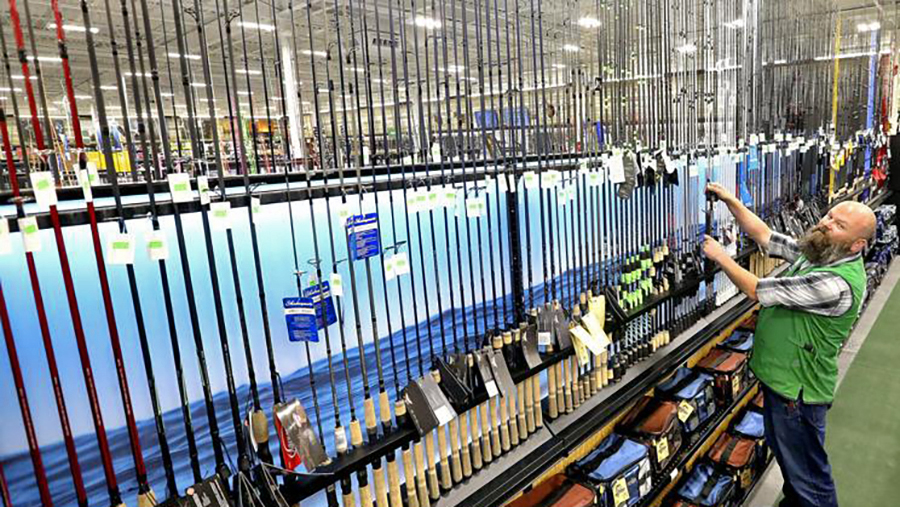Sportsman’s Warehouse Holdings, Inc. delivered a big surprise to the positive side on Tuesday, April 1 as the retailer showed it was not fooling around on April Fool’s Day when it promised to flip the switch and move toward profitability and positive sales growth. SPWH shares were up by over 44 percent in pre-market trading on Wednesday after reporting fourth quarter and full-year results Tuesday afternoon, reversing a downward trend the stock has been on since late November 2021. Shares were down by two-thirds over the last year and down 83 percent over the last five years at market close on Tuesday, so the increase overnight was still a drop in the bucket for what the company needs to do to get relevant again.
“Phase 1 of our transformation strategy this past year was centered on resetting and rebuilding the critical fundamentals of great omni-channel retail,” offered company President and CEO Paul Stone, speaking on a conference call with analysts. “That included a reset of over 100 stores to improve sight lines, enhance feature space, showcase end caps with relevant merchandise, and convert the drive aisles into sellable space, all providing a much improved shopping experience for the customer.”
He gave a nod to the July 2024 addition of Susan Sanderson as SVP of marketing, e-commerce and loyalty as part of the path to growth again.
“Under her leadership, we’ve made a significant shift in marketing platforms to better align with modern shopping behaviors and has already contributed to improve traffic both online and in our stores,” Stone said.
Stone also talked up the February 20025 hire of Walmart veteran Jeff Dunn who assumed the role as chief merchant.
“Throughout 2024, we carefully managed our inventory and continued to refine our merchandise to meet local and seasonal demands,” Stone revealed. “As a result, we ended the year with both lower and much cleaner inventory versus the prior year, and we generated positive cash flow. As I look ahead, I believe there’s an opportunity to gain greater inventory efficiency as we narrow our focus on what the customer values most.”
He said Dunn will lead that charge, “bringing decades of experience; his leadership is making an immediate impact.”
Seeking Alpha noted in its summary analysis of the call that analysts showed cautious optimism base on the questions asked, “focusing on the potential for positive comps and margin improvements in 2025.” Analysts also continued to focus on inventory management and category-specific performance, similar to last quarter.
It was on the September 20024 call that Stone said the lowered outlook for the third quarter (and year) was due, in part, because the company ran inventory too low in the first half of the year and did not invest in the right amount of inventory, particularly in core products. Further, the company did not invest in the right amount of inventory, particularly in core products.
Business Transformation | Phase 2
In talking through the next phase of the company’s transformation process, Stone said the goal in 2025 is to return the company to same-store sales growth, improve the growth and overall operating margins and pay down debt.
“We will get there by simplifying our operations to focus on our core business, Hunting and Fishing solutions,” he said. “Going back to our founding in 1986, these two areas are the DNA of Sportsman’s Warehouse and continue to be what most of our customers come to us for.”
The CEO cited 2024 consumer research showed that hunting and shooting sports remain stable categories with consistent demand based on participation rates, and fishing continues to grow steadily, boasting a 10-year CAGR of about 5 percent.
“These are robust businesses with plenty of room for us to grow, and there’s a unique role we can play in the market, he said. “We have the scale to offer competitive pricing and the community connections to be the local hub for hunting and fishing. We can out-afford the local independents and out-local the big-box competitors.”
SPWH said it has defined four strategic initiatives for 2025 to leverage and enhance its competitive advantage.
No. 1 — Be Narrow and Deep in Hunting and Fishing
Improve in-stock levels in the 20 percent of key products that drive 80 percent of the business.
“We do this by improving our merchandising efforts to win the seasons at a local level within hunt and fish,” he explained. “Over the past several years, we’ve tried to be everything to everyone rather than focusing on the core hunting and fishing items that drive the majority of our business. This spread our inventory dollars too thin, resulting in out of stocks in the items that matter, continually disappointing our customers.”
He said the company has made the necessary adjustments and technology investments to sort and merchandise to the store geography and be seasonally ready by both occasion and species.
“We are already seeing the benefits of fishing where we are comping double-digits by being ready and regionally right from the start of spring fish,” Stone noted.
No. 2 — Lean into Local
“We do this by leveraging our talented store outfitters, who have the local connections in the community and the local knowledge our customers seek. We will also leverage our outfitters as local influencers, sharing their stories and content to connect with local customers,” Stone explained. “On the merch side of local, we will provide an improved offering of local brands and products hyper-focused on the needs of that market. Each store now has a merchandising voice to help ensure local product needs are met.”
He provided an example of the Alaska market that is unique to all other regions with its local needs.
“Historically, we’ve not provided the local autonomy to successfully merchandise those stores. This year, we’re already set for spring with local brands and products that the customer expects when shopping our stores,” he said.
No. 3 — Become the Authority in Personal Protection
“Personal protection, a 365-day a year occasion has sizable growth potential,” Stone suggested. “Today, personal protection is already near 25 percent of our total sales with a narrow focus on firearms and ammunition. If you look at the statistics, 72 percent of U.S. firearm owners cite protection as the primary reason for ownership. This part of our business also appeals to a broader demographic than hunting and fishing, providing opportunity to attract a new type of customer. We are building key product depth with important personal protection partners such as SIG, Springfield, and Glock, names and brands that resonate with our customer.”
He also said that range shooting, which is a part of the retailer’s personal protection business, brings customers in regularly for firearms and ammunition. “We have deepened our relationships with a few select vendors to ensure we are always in stock in key items for range shooting,” Stone added.
Stone said the company has signed an exclusive store-in-store partnership agreement with Byrna’s less-lethal.
“We believe this is an incremental purchase and compliment for the current firearm owner and a less intimidating option for those who are not comfortable owning or carrying a gun,” he explained. “With our already established stores and websites, we believe we can drive additional sales by leveraging our marketing platforms and burn a strong base of influencers.”
No. 4 — Strengthen our Brand Awareness
The core of the company’s business strategy is positioning Sportsman’s Warehouse as the go-to destination for local hunting and fishing solutions.
“Currently, our brand awareness is very low in our trade areas,” Stone admitted. “To address this, we are executing a focus plan to expand brand awareness, drive traffic, and reengage our core customers. We have significant upside potential in our trade areas, and it starts with ensuring customers know we are there and what we stand for. This starts with redefining our brand equity and launching a new omni-channel brand campaign to ensure we stand out in the marketplace. We are also building a robust content marketing capability and rolling out an integrated grassroots program that aligns local sales planning with community activation.”
Stone added that the retailer isalso implementing an omni-channel selling approach centered on big-bet promotions that capture customer demand.
“Through this strategy, we will strengthen our brand presence, increase transactions, and reclaim share in our core market,” he said.
“Setting underneath these four strategic initiatives is the continued strengthening of our infrastructure,” the CEO noted. “For example, we’re in the early phases of operating BlueYonder, this will assist in our improved management of inventory as we define the tools and processes to formalize our approach to fizzling and locally relevant merchandise.”
Stone said he is confident in both the plan for 2025 and the team’s ability to execute with speed.
“We hold a unique position in the outdoor market and believe for these major initiatives, we will return Sportsman’s to sell growth, improve our gross margin and further pay down our debt,” he said, concluding his prepared remarks.
2024 Fourth Quarter Details
Sportsman’s Warehouse reported fourth-quarter net sales amounted to $340.4 million for the 13-week period ended February 1, a decrease of 8.1 percent compared to $370.4 million in the fourth quarter of fiscal year 2023. The numbers were said to be at the high end of guide range. The net sales decrease was said to be primarily driven by the extra week in the retail calendar in fiscal year 2023. The additional week of operations in 2023 contributed $27.1 million in added revenue for the quarter and the full year 2023.
On a comparable 13-week basis, fourth-quarter net sales dipped 0.9 percent compared with the fourth quarter of fiscal 2023. Same-store sales decreased 0.5 percent on a 13-week comparable basis compared with the fourth quarter of fiscal year 2023.
Company CFO Jeff White said Q4 represented the third consecutive quarter of improved same-store sales trends and a 520 basis-point improvement over last quarter.
“We were pleased to see month-to-month trend improvements as we progressed through Q4, with positive sales comps in both December and January,” he commented.
By department, Fishing was the best performing category during the fourth quarter, as it was all year, with comps up 10.3 percent on a 13-week comparable basis.
“This is a department where we made significant improvements to our end stocks, rationalized our SKUs, and at the same time lowered our total department inventory,” White observed.
Camping was up 5.2 percent in the quarter driven by “improved seasonal readiness in this category.” Footwear and Apparel comps were down in Q4, but White said they were still lapping tough comps from the prior year’s clearance and liquidation events.
“With inventory in these categories being down almost double what their sales declines were in Q4, we are confident in the health and productivity of these categories as we move into 2025,” White added.
The Hunting and Shooting Sports Department was down 1.7 percent year-over-year. White reiterated that the number of firearm units sold increased mid-single-digits for the quarter.
“Given the pressure on discretionary spending, we are seeing a trade-down to lower-priced firearms, which is pressuring our sales dollars in the category,” the CFO explained. “While there is currently a trade down happening in firearms with lower average unit value, we do see average order value remaining at an all-time high as we continue to place emphasis in our stores to add on and attachment items.”
Stone noted that the company once again outpaced the adjusted NICS data, suggesting SPWH outsold the industry.
“In Q4, the adjusted NICS was down 4.5 percent; however, our firearm unit sales increased mid-single-digits,” he noted. “That trend carried into February where we once again outpaced the adjusted NICS, this time by [a] double-digit margin.”
Stone also pointed out that e-commerce-driven sales once again comped positive in Q4, or up double digits in the quarter, building on 2024’s overall momentum.
“More effective marketing and an improved user experience for higher traffic and transactions, [are] trends that have carried into 2025,” Stone commented. “We remain focused on strengthening our omni-channel strategy to enhance the seamless customer experience across our digital channels and our stores.”
Gross profit was $103.6 million, or 30.4 percent of net sales, in the fourth quarter, compared to $99.4 million, or 26.8 percent of net sales, in the fourth quarter of fiscal year 2023.
“This 360 basis point improvement was primarily due to improvements in our Apparel and Footwear departments versus last year’s clearance events, which pressured gross margin significantly,” offered White.
Selling, general and administrative (SG&A) expenses were $100.0 million, or 29.4 percent of net sales, in the fourth quarter, compared to $107.3 million, or 29.0 percent of net sales, in the fourth quarter of fiscal year 2023.
SG&A dollars were down 6.8 percent, or $7.3 million, compared with Q4 last year. White said the most significant year-over-year decrease was in payroll, down approximately $2.4 million from last year, and other operating expenses, down $1.8 million.
The net loss was $8.7 million, or a loss of 23 cents per diluted share, in the fourth quarter, flat to the net loss of $8.7 million, or a loss of 23 cents per diluted share, in the fourth quarter of fiscal year 2023.
“During Q4, a $10.1 million valuation allowance related to our deferred tax assets was created, which put us in a net loss position,” the CFO explained. “This non-cash allowance does not affect the overall profitability of the company and has been excluded from adjusted net income.”
Adjusted net income was $1.6 million, or 4 cents per diluted share, compared to an Adjusted net loss of $7.5 million, or a loss of 20 cents per diluted share, in the fourth quarter of fiscal year 2023.
Adjusted EBITDA was $14.6 million, compared to $5.3 million in the fourth quarter of fiscal year 2023, reflecting a nearly 300 percent increase in profitability.
Full Year 2024 Summary
Sportsman’s Warehouse reported that full-year net sales decreased 7.0 percent to $1.20 billion in 2024, compared with $1.30 billion in fiscal year 2023. Net sales reportedly decreased primarily due to the continued impact of consumer inflationary pressures and recessionary concerns on discretionary spending, resulting in a decline in store traffic and lower sales demand across most product categories.
Same-store sales decreased 7.8 percent in 2024 compared to fiscal year 2023, excluding the extra week of sales in fiscal year 2023. This decrease was reportedly due to lower sales across most product categories.
Gross profit was $370.5 million, or 30.9 percent of net sales, in 2024, as compared to $383.4 million, or 29.8 percent of net sales, in fiscal year 2023. The improvement in gross margin was primarily due to increased product margins in the apparel and footwear departments versus fiscal year 2023 when clearance events in the apparel and footwear departments put pressure on gross margins.
SG&A expenses decreased by $20.1 million to $388.7 million, or 32.5 percent of net sales, in 2024, compared with $408.8 million, or 31.7 percent of net sales, for fiscal year 2023. This decrease was said to be primarily due to lower payroll and pre-opening expenses related to ongoing cost-reduction efforts and the decision not to open new stores in fiscal year 2024. On a per- store basis, payroll and other operating expenses were down approximately 11 percent and 5 percent, respectively, compared with fiscal year 2023.
The net loss for the year was $33.1 million compared to net loss of $29.0 million in fiscal year 2023. Adjusted net loss was $20.2 million compared to Adjusted net loss of $24.1 million in fiscal year 2023. Adjusted EBITDA was $29.6 million in 2024 compared to $24.6 million in fiscal year 2023.
The diluted loss per share was 87 cents for fiscal year 2024, compared to diluted loss per share of 77 cents in fiscal year 2023. Adjusted diluted loss per share was 53 cents for fiscal year 2024 compared to adjusted diluted loss per share of 64 cents in fiscal year 2023. Earnings per share was impacted by a non-cash valuation allowance on deferred tax assets of $10.1 million. This impacted diluted loss per share by $(0.27) and has been added back for adjusted diluted loss per share.
Inventory and Liquidity
Inventory management remains a critical focus, with potential risks if seasonal readiness is not maintained.
“For full-year 2024, ending inventory was $342.0 million, compared to $354.7 million at the end of 2023, a decrease of $12.7 million and better than what we expected when we reported Q3 earnings,” White shared. “Compared to the end of the third quarter, inventory is down nearly $96.1 million. We successfully moved to our seasonal inventory during the fourth quarter, which facilitated a cleaner and better-than-planned inventory balance and debt pay-down at year-end.”
White said the transition to a narrow and deep inventory strategy, the further rationalization of SKUs and vendors, as well as moving more efficiently in and out of seasons, will improve the productivity of inventory, again citing the example of the Fishing department that gives them confidence in the strategy.
“When we have the right depth and the right products at the right time of year, we become much more productive with our working capital.”
For the full-year 2024, SPWH incurred approximately $14.6 million of net capital expenditures, primarily related to normal store maintenance and improved infrastructure investments in technology.
Total CapEx for the year was about $5 million lower than expectations.
“In regards to liquidity, we ended the year with a net debt balance of $98.7 million, generated $19.7 million of free cash flow, and ended with total liquidity of $131.1 million,” White noted. “We used our cash flow generated during the fourth quarter to pay down debt, and we’ll continue to emphasize debt pay down as our primary use of free cash flow until we reduce our leverage ratio.”
Outlook
Sportsman’s Warehouse is estimating fiscal 2025 net sales to be in the range of negative 1 percent to up 3.5 percent over 2024.
“Through our improvements to core product in-stocks and focus on local relevance in our grassroots categories of hunt and fish, we are confident that we can drive same-store sales growth in 2025, even given a tough macroeconomic environment,” White offered.
SPWH expects adjusted EBITDA for fiscal 2025 to be in the range of $33 million to $45 million.
“We will accomplish this through continued management of our variable expenses and modest improvement in our gross margin,” the CFO said. “We expect CapEx for 2025 to be between $20 million and $25 million, primarily relating to technology investments to improve store service and merchandising productivity, as well as our normal store maintenance.”
Regarding tariffs, White said that given the business’ low penetration in private label and the countries from which they import, they believe exposure is relatively low and expect only modest gross margin pressure.
“We will continue, however, to work with our vendors to assess any downstream impact of cost increases from higher overall tariffs,” he said.
“To reiterate, our priority for 2025 is to drive comp store sales growth, improve overall profitability, use excess free cash flow to pay down our debt, decrease our leverage ratio, and invest in needed technology,” White said in concluding his prepared remarks.
Image courtesy Sportsman’s Warehouse
















